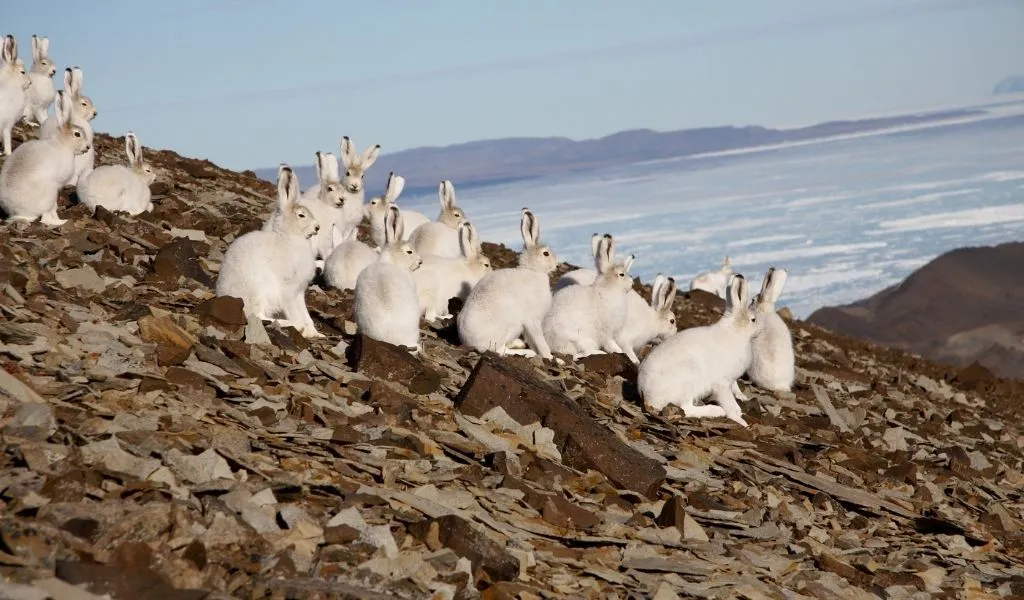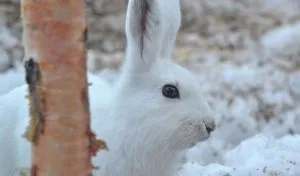Many predators in the arctic are optimistic hunters, meaning they will eat any animal they can find and catch. This is an excellent strategy for surviving in harsh environments such as the Arctic, where food can be scarce especially in the colder months.
Unfortunately for prey species such as the arctic hare, this means there are a lot of predators with different hunting strategies to watch out for. So, what are the predators of the arctic hare and is there anything the arctic hare can do to avoid being next on the menu?
The natural predators of an arctic hare are arctic wolves. arctic foxes, red foxes, snowy owls, lynx, and gyrfalcons. Humans are also predators for the arctic fox, especially indigenous populations.
Keep reading to learn about which animals are common predators of the arctic hare and the strategies this prey species have evolved to help them out of hare-y situations.
Is the Arctic Hare a Predator or Prey?
Just like regular hares, the arctic hare is almost entirely herbivorous so they are not predators. Arctic hares are a prey species and are an important source of food for many predators and scavengers including mammals and birds of prey.
Many predators in the Arctic are opportunist hunters and so they will eat any animal they can find and catch, including the arctic hare.
Predators of the Arctic Hare
Many predators in the Arctic hunt and eat arctic hares, but some predators have preferences for different prey species or find some species easier to hunt and kill.
Below is a list of predators that are known to eat arctic hares, but for some of these predators the arctic hare makes up just a small proportion of their diet.
- Arctic Wolves
The arctic hare is an important prey for arctic wolves. Scientists studying arctic wolf populations have found a positive correlation between the number of arctic hares and the number of adult wolves in the same area1 (source: Mech, L. D. Arctic, Vol. 60, No. 3, 2007). This means that if there are many arctic hares available for arctic wolves to eat, more adult wolves can survive in that same space.
2. Arctic Foxes
The arctic fox is another predator of the arctic hare. However, artic hares make up a small part of their diet compared to lemmings and other mammals2 (source: Dalerum, F., & Angerbjörn, A, Arctic, 1-8., 2000) 3(source: Kennedy, A. J. Arctic, 366-368, 1980).
3. Red Foxes
Just like the arctic fox, red foxes also predate on arctic hares. Interestingly, scientists have found that arctic hares are more likely to be killed by red foxes compared to snowshoe hares when their habitats overlap4 (source: Small, R. J., & Keith, L. B. Canadian Journal of Zoology, 70(8), 1992).
4. Snowy owl
Snowy owls have been observed hunting and eating arctic hares, but they typically prey on smaller mammals5 (source: Wikipedia).
5. Lynx
The lynx predates on arctic hares, but scientists have found that they are more likely to predate on snowshoe hares6 (source: Saunders Jr, J. K. The Journal of Wildlife Management, 1963).
6. Gyrfalcons
Gyrfalcons do predate on the arctic hare but not all gyrfalcons are large enough or strong enough to successfully hunt them7 (source: Morozov, V. V 2011 Gyrfalcons and Ptarmigan in a Changing World. The Peregrine Fund, 2011).
7. Humans
Humans are also predators of the arctic hare. Indigenous populations of humans hunt the arctic hare for their meat and their fur, which they used to make clothes8 (source: National Geographic).
Other predators of the arctic hare include mountain lions, ermines (stoats) and, rough-legged hawks 9(source: Wikipedia).
How Do Arctic Hares Avoid Predators?
As you can see arctic hares have a lot of predators but don’t worry too much about these amazing animals just yet. Arctic hares have evolved four cleaver strategies for avoiding and escaping predators.
- Camouflage
Many animals use camouflage (disguising their appearance) to hide from predators10 (source: National Geographic). Arctic hares use a type of camouflage called background matching, meaning they blend into their environment to make them harder for predators to see.
This is harder than it might sound because the Arctic ground drastically changes with the seasons; the ground is covered in white snow in winter but is an earthy color when the ground is bare in summer.
So, how does the arctic hare blend into a ground that is always changing? Amazingly, arctic hares have evolved to change the color of their fur with the seasons by molting and growing new fur11 (source: C. Rowe, Defense Against Predation, Encyclopedia of Animal Behavior, 2010). This way the arctic hare’s fur is white in winter to match the snow and brown in summer to blend in with the earthy colors of the ground.
2. Seeking shelter
Arctic hares can also hide from predators by seeking shelter. Arctic hares typically use natural shelters formed by rocks or snowdrifts but have also been observed using man-made shelters12 (source: Gray, D. R. Arctic, 46(4), 1993).
3. Running away
Arctic hares are very fast. They have evolved long legs relative to the size of their body13 (source: Klein, D. R. Comparative social learning among arctic herbivores: the caribou, muskox and arctic hare. Mammalian social learning: comparative and ecological perspectives,1999) which allows them to reach speeds of up to 40mph14 (source: National Geographic). This speed helps them flee from any encroaching predator that manages to spot them despite their camouflage.
4. Eating in a group
Arctic hares have been observed foraging in groups of up to 300 individuals15 (source: Finley, K. J., & Evans, C. R, Arctic, 36(1), 1983). By foraging in groups, arctic hares can look out for predators together. Even if only one or two hares spot the approaching predator, this is enough to alert the group to the predator’s presence. Arctic hares can then either run away or try to hide in a nearby shelter16 (source: Gray, D. R. Arctic, 46(4), 1993).
Related Questions
Do Seals Eat Arctic Hares?
No, seals are not known for eating arctic hares, they mostly eat marine animals especially fish17 (source: Finley, K. J., & Evans, C. R, Arctic, 36(1), 1983).
Do Polar Bears Eat Arctic Hares?
No, polar bears are not known to eat arctic hares and typically favor marine mammals. However, being opportunistic hunters, they might eat an arctic hare if they happen upon one and food is scarce18 (source: G.W., Iverson, S.J. and Stirling, I, Ecological Monographs, 78: 2008).
Do Walruses Eat Arctic Hares?
No, walruses are not known to eat arctic hares. Instead, walruses are more likely to eat marine animals including bivalves, gastropods, and fish19 (source: Sheffield, G. and Grebmeier, J.M, Marine Mammal Science, 25, 2009).
Do Snowy Owls Eat Arctic Hares?
Yes, snowy owls have been observed eating arctic hares20 (source: Wikipedia).
Do Humans Eat Arctic Hares?
Yes, arctic hares are hunted by humans. Humans also use the fur of the arctic hare to make clothes21 (source: National Geographic).


